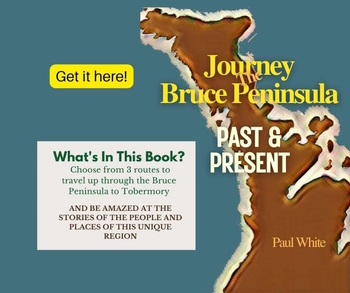Menu
- Home
- Contact
- Books
- Bruce Peninsula
- Georgian Bay
- Hockey
- Owen Sound
- Bruce County
- History Pages
- Aboriginal
- SUBSCRIBE
- SHOP
Please enter the Password.
53616c7465645f5f1b2f4f2137332a08d9745e234a65d4873278e19bdf1c7f698b5747442846df9b28faca7824a48b5d1525eae0185233c784cca2c5fcbc77280f16a4c45eda11fa822d716d02c94c991a4ee384cfd560920e5a6138a8115a61eb96cef53dfaece993014e5bd62b56698f6660229ee2c802ba334fdd61a68f9999efdfdc8771d69a7c33a444c99cc497cc23d3fbbf921b6271d19ad26304d1010fc2a2a1b1fc0ce7297878fc59e1f75ad2adeb2a1776d6eaa02a3d2538ad23d18eb2f6d03d6984838db8f0fa66c9472aa0da1f562864934cd20d122ab4f65b05a9851c5625bb8fe58aba32d3b30d32539d61a282d4d45c370ca70b7512ff8b36bc8ab602b136f34b860ee6dfae964c20b3f6c36a5cc4ae8ebbd28bb5392b80d559bfac48b18d64c52ab4102dbfd385874821ed4c99467ceb44f324581aac37c1b4d4407c829c48f28a0c407ff14e74911a9c075d5d57d31ac16e398534f38d22c0674367096feb95bee8f5926cb879eafe27a9b6899a51a169bc0f1291e6d0288e5db3cd73a0d6c2c9784beff0bd7e975b35997cd6dde0ba0ba762d88bc8b8f29062d51c925d460f0b7c541c2a4ca6ecd42198247bb7de633caf9fed8e69d1802d13d2740d61ddf7e90521659bf04a93c63ed1ac21424554945e63b722ad0ec946a8f1b9e9677d033338b2e4d4e686e63788cd7ddb2075e801303671c39b6fbca696da8fbd00b8549cf46a6098a6cb3be7535fa5993685e6aa9cf7e8bf2fd84823d0aa51f41d25b533bb0f559660174579acfa0d62ee6206cc50439728135946e5149d09e7e80c90a206aec1920944268fc637c9e21adeeb5516a644551c95e52d870013fe20d50dd2b2b310fcfb1d611b0aae3906da384167c408070074b4a588e30c031edf398c291aa5a80bdc04f7a29b6ccebe079eca2087281460d46fc262d3ac5755d1eb91036f2ab6fa9493e39a00f8edb7784702579fa2ba595e6f6ee411ddd36e97ffcdc41b3923467a325e902d18c8157ad45cff037b8726ac5599f92be5c6a2675ef670a8aa1c32bc70b0259514bd0c32faf0223ae076822e28f2a44ddefd6b0c6de0ac615ae6f6b5ba7b176bd5c93852493f67d631d631e3a16fcc5d98992c08ecf0390beac84f0179b7994ca807098eb6ce191cd39627e4d7d39e5a77edfcdd66a27dfd21f953b07084f140bddc9f64d21a71d3b79e0355e9d587e4d8f17e4ce614343d90c2eed8690c018e3c43fac36e5cc3175f7f593bc08cf83f35c3c7fcd652aed24cd1bcdaf4e14085f1dc8ed75461be15dbb506edb32b43693aed6e0e39e9d2e392b94f9b02bd1d96af15429f7e92ac684a5f6a9ee4e5814305335332a09d6f68cc1787316016e6766c1e39500887abb880a05ccf5ef8d427d0d8248725e80ad62301cb914b6320b91ffde7d9b8a149e0d02bb6e6e58750ffe23e4ed8773481bc1189fb9f484226e1aca0dacc3d6f735a6893b42c39f3562b580f4e811e372608dec3bec750b8aecb9c0680b4a1cbadd8dcab68d81f804a0893367601c86ce3a723a8422dfb678e14eaf76ea69efe925fea12e409de11d80057dfee34bfb82fc516ebd41e82f62d581bc3ceab0ac0aaf248ccf041b4b77afbc07eb1667c910a83468d63453f6a34b2aeafdd5b953ef18fe78439c36343ee4978945c08b3debf33454aea42cfc251fb8d37d0c2af0884e576cd38bba3868e30930ba0799141932fdfa6d98348618b36e244a02d67496bcb72804c458e8f48ceb9abb09a868d1ede094626a2c84e2ffae6d68e7e997858197e13b8bc1aef8f517a168478e3b587b7ef1368d625590cf81a93cb8c61e16098b9357e8e65ccebc8ca0673d9584fff379e77d13a6d2273bdcc588d4a070880d1ab4896b92cac0f7c2ec4b884a0f297e704c3a9a115df57fab67954df809780ef1569fd4e7b94994470c7618696e128ccdc52a7ade83c602979eb098e25717d12319a4088e5692e13623ffd4e8f8162c9a6e77144dda26337866ad293f6f7c25667cae8c585789fbd994c7c25a05e39861060094fcb6beac55fc1b2bc182109bd743259c0519f8c898e80a79da6045ed159ea6c1145eb55e69572b515a1802318fe6185c7764d16bb078f5ed576a9f319bbdfc91862bc5278552c19f14c0adb0664830da6f6fc4a25ae2bd6254cb49e845aa6acb4e2c3bc3ee8fa5a027923dcf9ed81c95f0b2c04a297218ef73f989a39cd570a959bb946d7882434df7f65a210715df9ea2b4e05f99248c063053e9a849c816e58896b53c331b02fbce3e0738b2276fdb800d7c7d5e3dc773ae0218906cec65cdfa85d25eec8d97448ab9925c5806877fbe14112dd78dc8e638d33a7ff8c98e6814bca99578527ce41e86b6215e45c03b8302d6ca7cfa6d88fb6d225c356ea3d8f9a8630d7c5844b126fdf3a0cc68190634bfa8afcdf506fe7c07766fc280b89c05ee796088aa97b631ad787c01ce982dfaa3f991747f6b74f828defadedd4fcae0b3f7c94a9987e9c9c780e2aa03d47ab097774bd63ef587a4c5ad296648a9df1efc4edca160522b91cb0b9f3581a29b4c2653d646c75e5b5949913befed7abade3cd9c32320b19ddfe4819f38bcdc574dbe84c2a4baa4cec6db07d0cfbb9d880b7dd3c6c2ff19216773a8425412821a05424d837830eebbe4117ac63ec5468a000d4dba77bcb79ace6dca0902a6c4064a3e904a01fcaec9c90979ce0794940a84d91534e1fe24ca763c26ad4cbf09f0e78ae59e2b7a004174250708ebf0c151165b985d64373cec285d823cfae88fc0e3021d79ce361d50e309c902d080ccc2f38884b56124053e151ed1dd07162a1ab2a5f7790d024a9ab349e7e310c25248631e7c657168159e89337cae5b223ff16b7e0ec85331fe429514673fc9bf94555cc7e948c8f4dbeac068a65d2e032c6684c39b16d462321f08bfac3c375850eec860ee1b8723e6f700e908fdafd606f187b4e559c7a3f98f06fa466f0105ac8fe50c960b2512f4e5efa6c7a6c1e2296d1d06c3fe26c073d107d3eb22d1030bc77c3519b814454c0bb95cfc4acd9526b7a89afb67066086f226d5f82f5cd869615431c9764ef62d1194805def87f94b1650fa8b00240cae5ba01c1b9705108221c520cfed44be04e0be1e15bf36d87fcc29ccb7a8d8265e327a9d2d71fbf69313303ee367d5426f26a33a4548762f8e2068336fa2f76d503618364642765715325dacf7c74b7f2438d0cc92d8d39b57f6849327613872d46dc33e467c4e80ef0d704baf0a06765da68ca421ff9d389a5b98dbc35390ad8e5430c944b67676514dee45d803963186cc12cb6cb0c9dda7f348b3e9e614ae13f07a7766c146b5ddf29eb490f8413c22b237285e276647acf660f352ba416508b09c6227fc4656d1b39478b2017c21fb734d568dcadda77a3e40a1d6164ac6f9c06ead7fff80466ac99f46fb333f5dcaea69b6ecab9f85b81b6660076fa6b46907fe711856cb5e114c31f89633e961154e87509b2e66be68aa539d65ec9b8dd969a9b4cdac1a70aae8abda8fe8b0e8c383e579b591a3f4a8fb31be5bdb45ca192f029e2553a03977fa176e8cfb49f73532efe0150a4f8226589c80b0292f1aaca33df62b763e3e341777231ce3d58f492e8a9c0c4930ad773e2587f7f4ae061d799324280ca03bffd0c3800354092a14d1d26de72b68589b34d639b2f104d7ecacc990dde9cb9fa69eb35a7c74d85c2dcfeebbbc50b097b0d046ce74d9fbe0af25c6924fbdd14b5476e01035699e2fcd85aa1250cbf87d20199391346bc8675faf461bd896b2e93278432ce81bdaf2e463c72e9df3a21c2eb8c001b708c84da67905b320f4b2bd2c355f9516dbf533ce2f32da4057300578ad8d2ad190f657554f2ec797543ec27121a5003a6271833a8f7c4c6b149b222e148a95c5fb8a98bf55e40dce394ebf906cb61f9e74b7018561ca4b3ea2b7a449badc19f6f814ab2057ab771e3523d58b3bb96281d096001157bf150e0cad701480fedcf9e4a3ff3b629df8180a78583bed8ec6c1c196c068218668f4960cc10efbd72454a785be18114e96414f200742064aa538abb042cf618016404394c74855a877656e49299ca56ef30654698412cac4f090c8688e819a21115c8a053967d9b957740c9fa5ec7c714b42167100161c11ba2bc55c1f687f58d65e99ffe6b4172ff678aee310160df9170f682f275fd28584f2086129c292b69adb2178630bcf048c83bf8ab7df18455c98ae1bc741d058802e7150f6233d28963bde904a9ed8dfb70fff023abb8cd4dab8c432968614ea84c34cfb75ae9b92dacf569ea46710adcfcf278271174b8bd27f699326bd6fba2a897e80f5930cc954616d09c6ebf1f2959bbec39517ca23f6f010a4fb1718b69dbc7641a43643fea46f314d1c0f8fa3b1e2fdc02f62ed25fe59c6be5f6e73ec830167b77b1b653ad33feeb17263fc8e2fb724b1d1213888e7c3d0df7fa803f1d11115fd064b2e3ce2f499c2991d3ddafcc963aba6c2f58ff16b989f517e360c9a57a94a99b7ad9a4713a2d77677b17e8694880c53ad82d77a5415d6e488b70db758c8f469841c8de6136c84cd37db073b9838136b95684290d32128854618fc111506ab0bc2cd2f70cccb2f6cd46194039d6b6c6b0f7aaf6d67cc2ba2dcc7cdb5fd4791fe3f2db8c896e4672de708bc446a2a3207110bee716bcd58b6d1246168c7432e616d5173b71c0bfbc6c98a727e1630a70166fcd3ea54461f32c9abc6813704851e18dd097fe4bbb6d4a0ed2a40644a5d1b7cf113f986963d1e977a131ef0c51b7d19166b9f1ea463783187c9043f91cdb683ec7de4f3c226b18f41fcd3dccf25f150617b02a0dea44611263a039da397272f3dddba2278e1605697db23933b0e603b17f6aa39e3a7d54fcde84964afb9a0326e3489a69679e75363b0b4c7a62f2e4b1b65734b7609a6b04ed2c7400bc62afaa85be6e3d1eb2552435b30c45501abb2ea2ec0ecc854918b6f59462df9716fc84e4262438be18d07297f2616966b092615e63e307999526700d1c3aae35f0b5275dccbf638fe36f3eaceece5b2bfc16bb6694e9879b222c2571c56d6a80526cb8748011b5b35054ab4da5c69d2504b5575a6a17ea327bdc6796bc70275ff3549101b79701c772257c5dc0b95d8080f73fc213806b7aadceeb24bc72d8ac9e5fe6401b028c4dfb67b33fc81a1e4025a7cde0acb0ef29b5a55cbd2056cf42e1f6bc16df9bc813d84cf81a6c0257f6ebbba68a306ac4f8938a0cb291951d79a934f686e2040f5a0b46c9ff44ab68158ab39db54a31d2865a7f68f74f99b30ef96e4462efea051628e3a403c3263fa8c4983c0444f5f045a36473bba14f9ee7def52474a1d51923cdab0ef48728160796303f79c5919967c72c946abef53dce67e489e9672dbabe450ee217bea6ca11fcf903ef48b15b1e6e02c4b2e523e5aab5057c6506499816262ca6d1301231d4ba17e04d195990d773201110cc633d21b34eaeb7815be7d21304f9de518bc030051b29f8d70c2231e3051a2ada25d067551d398aee1b917d7722f45ca775b9c1992b00ff65f562acc2bc08a735f772c39cf75c7b96c54d38af6faf23e54ca168274a1c28d4b1697ba8dee2faf00eb3bc4679ce76a2f06495caa965e6ebe0c82d6aad9d3cd7e41739c0b7f95c73fd0b27fe33e5a8499fdd8542d66cb1c6d95a4fab4373cbdc49a3e2e59b73068616404825709495a7d388fa4d5225dc2523b4e9b141654c6104a5efa9bf1cc9d08c1b0a643fecb292ba7d896b9364c7db8af57f358f95105602d289a034e5f28d06ccf40310b94d7121ffb767b1772cf1b6c0e390dc0ece17855a6e974010ced44813348b2f1f3ff4a2a03e4c50ce3142e5fea25d4422bb2a58323429381bc3201cf6c42efa68f20c4e8c36320803024174322b69a95ff18d1db395fbccace91332db452031ce90943fe254930bb213ac2204ee164e97d2a0b178873faa67631ddde3bf38de5fae700025c6c0503a4c7918b6801893042aa97d5372fc8026c3537367737ba867d0907475021ad328c64e97a6ef0fead78fc4e6f6f15a8f7f7cc67a011ba921d48eb9cbc28d359b36aab55963507fdc9828f94c28ea5dea7a04989e0939adac44ede49499a217060082d9fdb674a0c2e08d348409363c91e7bc77d5567ff0f5ab5bad6848ea7ff5ec1e7d3d455d956898b6ac2340cea7b9784fee5d43195c869e4a30906dd3c792b8cfe5f1daaa769bd61e89c9d4c26a7958136780cf37b7f38e24277bd9012d1a10e0d13e6859fbbbc9f27cda0583d79a2d51aeb96e0077809db1faab6350e8c87d3ed0ba314f3bf72ecfc52ea90ffcc6e7e53f1db50c90de8249600fe6f3ac6e3ec6c0da49b34913a65c44aa414d7728977c151611599781839c9ae72de6529dc7effb77488454c45f6a1e13da4421398499b39db2338fb450bce632ac82b7d6ada44599b84158477342d7beef33fe8fdcd0e9416ce6d909c2cbd49c215fdb3d54d618164f6b8ce72468dd3611d246a1bed393f6732bcad1c2d3e319c4aedf9f046358543fed32e503eab894e60386f359c1fb4a72c884d15330c4004dd21a8e495370f1910169e42bfb7108be73186586857d08a3b944075b39ca00ea7adb182ef7d84d2b24a306994b8352817d5e0b494a8633efee6f8d32afbc6828bf4586561f7ee7e3e988ba1d6bf458236812612f5424e367776260ca8079c6d1a3f427669b4509257ce18b59d47a64dee6fdda8cd3692b79fc39e3ab9bb6de1352b3c3430e0435d12d3ceec44f5470db53fbb1c5c7270a99a16ecb2e6b1f6b43b607d702fe4eae45907542590c9f41d611b1cdf81241bfe6c9a4b55b5b1b10f2e266615ae704a5545e22d9901ba0ccac1d0efcfcd949875b8db5533ded16d6f0017ddbcbc0dea8a4212aa3cc62457472692e1c26de09c0e370bbaa209e9a9e86a8491f4aa20fbf46a1513600043018fc32cce140090b67231b8ab84bff749a552c86ca3b567ebb2e951dbfcb1aae3371f5096e08bd5938b723cde92f40be27a8c722d1a4f77cdeaacbdd5db5ea4b104d3b643a2d5cbc471b87c9b19c6f33893d9adc59381c763c5f084b3cac5eab4b219c30d99738a833460058dac6fb5cec8caafb44de5983588b71e1d18fbcb5e3f6906744a48133d27d01cb53395f797a859b9a0281b57dcb5df121e2dad9cc728354f2664181051c2e87a71239fc316e77f651bda733b651bca6ffcc5de6d91390bdcca6578b98adac7557e80108cfd819a9feee778b86213fdf6d63b51c95a7bb3f322f5b1592f72446707cf69aa81cbf4760d11ae2d4afaa03318d1fe364711fc32c7bdd5b989d2ff53bf87c11baf73666904cd9cb941696c82f96914c0ebc9feb18e5f6593d31baa53febcf25fa588664dc95a2813a62a4562d246c0e80a418ec638513a13855dda12f46a2d53aad6535f374d63e4be886f66a7e44327a4ade1c872402b679aff0cad77c4d6fbb6a1ce1cbfbce8c6a771523ba818638a6319f16071b05fa04da9e92e61d50874dff742ac65c7e7161098e47837cfe30dcca1526cba81dc83446c6b4395025d0d801a10a5427327ce30738e172efbf047066f8a1c4880b99e5d90173f284d8f2c4d0fc2f4b015703234096361ec7bb94b76e3ac92c907a407137a1f92e22ddc0150bba1a3efbb047895ef65a15164c64dbcc6106125f0d18b6fcee25a78780b5ea89e8a85fa3fa28e604b79046c01a57c8ceee7032c18e789a5bf06377a16b4eb26d9fff0579383d08785ef5be089497c4c85594dc2c184659461cbfb594255add47ba0fc65ef55acd70a3a46c13907a258094f66ffd35ae54e84a964306b9272f2d12759983f21bd83b05baf6f907b9283ebd30c343f242fb45af70dbf0127ff5d8312f64440a23cf507371a25c25523494ff29001f6f4c97babd51bc1b7d92460b6db96e0cc7976d74b705f447af3a995b5811edc7595192bc5d06197ca75556e3c2f6d6125720007b866d78a5ae544640f154be5a65ca7cc50216234222b6e1bb4220191349e0b0b81a154be147392c5e0dd593e283f58ad28fea2bfd17c566abd82deddf2bb97cce3b457fd51783694f27f75434752284c490d9d6105d5ccb7bda888c4fb19d6013cad6c8c5c9ae62bde4e4f32274ccff478137b6238e1ad1fcee1f4d96f126939b3bd49d4c2195356f62594b363460eed560a4babda5e8c4986b2cbdeceef7c22ab3a684ab7f71db895c556284b07cda1511213da0cf0376b71c308afc81543ecc088fddd2b14b271fea801d9d9023d840f41380762475e15fdd63f829d59d86a9fa6166b0fa25979c883a6e8f22f71f6978b4ef10562f84c5a81fc3e72e3609b57cbeaf5416895ac7cc157f74b10920bd1ec471f274fcc34171a2b4f39e74b0c825cb3181b12c5c2f84427cd2af0444302bf002eacc9d8797db31cdc6cee1a852cb6e96bb8782d17e36550f28e3d53ab3374d853c80706b63bb1eb76623aafc41b5631725b91be3b8ac8a0b4868e83b5accd9cb6ebb11fac5558e59ecc12887ef1622cedfe30cd76e4935c669af5be9baab1b35e7346775f8550d2fe4eb9fdafe18c7538a1dd91ab4d612e2f38af39c8bb0e2db62e63b37acefca1957143a7283fa56ef0a0b5e335171e47c7bb54ff2512e9c04dc557159606f513b102d651301f17aa278f55a13eaab5ab5ada6c4590328e83533fa5f83798e087a804a79d2d5430b35eb478ee348a43d14e307d5e174f90915a42d796e379f1e4354b8237bff527cb234c9cd6f9fd80277dd6b626aa31ba760e69c63abcfa776213be092656e8ffe8f25e1f00ed675c22cec0807ad5db79805f84b2820ce84a04b55d676183bf33cc3bdc5a568849c9b88af33a0a7a4d574c6b1e6c9fa01489042cc122b8e254474e7eb2de6e1f011fc68b5b717bdf8d59e0660f57530afb0df4f47b6602a65cf7d7d7f4394427168321797bb22ff307108611ce45a5c8827229f853c865c4d0c5b4175d7150963939b33f77fbe3d7398cde61c782711e0987dc76a3c387e5072338b18eeb47720bb0bac47df1021f77709e40ac9106de77856a975e3de8cfdb678517850b44f46ca01cc6170116c82f2dfe749be10c7100df4a776635b5774f431f4deb102e9a1ff859ebd24fcc1e46c883c04989a9cfb4acc36c3f917634897078b7979c98050920cf553244185f696d0850b147d6dcc9d9bfdc82e067493d197a65a4ef9226d43ded4db6368c02127122def7e7c09c89bbe164cdc56142f653050731f2840024b921822846b8c730c0cd4fbb00dcf97724167401e571fc6a996e562163ef876c577e39b43522dd5cec7dbefeca2e99fac29ad9fad4f359e45adc9e2e9c29c89c4e7f11bd25158ab8e1b97ac8245e5742ede7d8d73de0dc5004b9f41e6500652224c2ad60b565cdbe4e0dbd682237254e3cdc40cbe2970e023034f99fb018c18e5bb61a5b48622568b1efe761c3c6ee4815f36fb39516c37a04337258af9c49920f191b1e677d8c20db3fde1645b338ec700c06cbbafb5d3d0b2f9eeda7f648dd07400ea0d5743cd783ac223caa9a1bfe7e38450875dbea7810ab2df531cdef3dffd5c97b704c8097723830acd8ef3af450ef41e18b39d629ec1b9ffbc292ea495f2b48450ec52f47e529c38acd38547731588a146098d59af2a90d29438d8b3e733775a7fd3430cb1ec5a64e9ba66d075087279332c69096b7e22e3dfd1fdf1bb21a4bf5c6058b1cbb73ba104d3ae0ea5f6a71738c8fc5a7df5cbb92221adfc9919dcd177ee74f86751bc17b39bf00684020c136958158e2de2201af917899f71e255b8a5926d2d8af866f7548aec8700b5066a8582222e570b63c48386525344f48c74c8d4237129ed114dc4f7d2ebd75e663f2f237fdb327944d1e29e0c7e93bfa7a2d6cc32ee6f0e43cca7eb129aacb46bd5eb81dd984f0d1218a1931018bf0969738b51758a7b7d0aab4bfd8829ce8294a2a65c88e29a622b4e1363dd006e34224d410becc42d4ad3ed20957164df9e7f6f74c68fb85eb6b6837375c4a0809316dc3580d736e9c0ca5f68adcc51a43f0a995c026675912274231f1275d436dd20ec483e6155b1c76745ea768f43cf80a31c4fb866fa4bed51ae58a50320a963ce7ca638a1cd736ad54989f569226827de272c9be33f273416d8666857374a8e9854b210528265b2e61886463b2fb547908fa55db3adcefc8bdee34aea0c4e05bb3a42bad42a8fd64a10bd2a7254d789c24652f059589cc8b579646e314e9ec5d17a67a1bb7b9598df1c8fe0b51d257d71494a13f84e66a16bdec41515b345982cf8aaa6dcad3561dbd6a59a7deef96f86fea7bb24b4850ebd45432d7c7deddc8cffca2856d7883fa050a595b80c9d6d9e20089ccc146a6540a918f6128fd39576b9557f7513c7c2232011e2484af160abe905a3b665a053e66bc5caa61cce5e468394d24cacbc027e42e869fd1e221f4ed5a2b3798a8679d7726404a7f8cf1bea9b2bb3a95b24f1e39e8472721c9f97b687845f962e1760dc741285ad6a5c220bc5dba0df47ef60b4636207346e1dd54e60c3ea4af67fe8dda7b44dfe4d8a062a7aa014500ee646f7c1f37c32e94a8734886ad789a52230c7ae64cefff75cf02a6652a34775d7028b59601df8fe0a39b0f09c00294f830450f1cd0125956e569fd8a6d0af2407e8e072b8720557f98e1b4428ab101d00b7736af70831d2832b014fe7a3a495718ec67dd7553aa3e828a1554847661e7c553f45e243a94bec9d47934a706a88c6c469dcbc11a55a82b0481016a1376fbb71255ccedb85a783b5d3b5f86c62434069729ca55003fcbc35b84b02032167c1900e1235f0ff349e84f275aaf556ca2192a3828915edd5fc3516b311c5138afc73433e2eb305d7bccd14ea448402288d1d65d3e46ce2c212223765383f9a00a60b3c6090607cd20f7ddddabab87bf9854ff65f7b56d053c04694af861119ab5609e9c19edcfa29ae5276263cc6d896ede88be6257b885b0fbb4d463808176e1c580fabd5f7fec47a457691a622322a143c409c32b2a6e79b3accdd68652080d25e5d5e4e55fa0c84bd70f5dd2640e7deeee4d68460e747b2947bcceefa1ab444470a69ea3543e1b0cf1d086df36410474bce303a972319076f2a066fb4acaa1cd4b709f7f901323b50e19601e4bcb15e6a061f3313a6143e912baa7ee9ca1402b29addeb6e6f89d01c625ac11d798c488f94d5952427d964e9003d85f0d8e2da2b8a5eebaa8f490bebf2e6065a21efa1d230a27822524c09f3136231d295e40a9a91b72281449c3437aa68965a189188fd0ebeb06a75883ef478e4d676c0a8732533edc5808bf2c5be52fd98919d17a651a1088740025330c7123d29c3d2fd6a6b5a064ea100c9b77f55e0655c2ad17d4acbc170c91eb8b454164c14462edaba40595fe8164adeaee7f5859730bf57db93addb41dbd85ceb827c21d179aa8460fa7bf0f76238272af63257aa0bc5f80f0a7afdd4ea97aae67aa4c8008da694e28e1458663496b5cf9602ea21fe1ce87df978863c5d0fb5dea294a90c2bbdd391b54aba72ad0ae104117ae25c4efa09d3feadf9f8bb67a6fe69bc33955a0bece6844c8db486d8cf75f79dab38c5eb35942137022afd0c649757ba056f77e1f9f9df597b88a7e2f631021682cbf079b3f4c98a14e94ba76f2eb19d76899e3459c71068b0ca017c135077a14c344547f8aefe66a52a47ec031561a352b18797ecfb25064edb46bcc39442f4c62bf15cfcab594cf36cefafe336be96e9200d11b66dc043d24de026ed3df92aef09515e6d86289ed7203a5ed6ea488dffff8535831823c1117f557d08edb233a4bad44e186b3b78b02ecdb1ed4077f9f27d29da4a6079f27db666e6417dc46aa8a55bc517f76b8f2658843929bdaff9ad3fabcd6d21a83afe9025135369d168b78069418153ff6104a77c6e8ebdb4d8f071bd67d594d8130d2a4b92ee6b2af0b7021744148c610fe8b7f660fcd66d87094face75a84f9f7d9c87d791be8eb5aa26129580586c64cf40107ae3ca0d2a081b67160832f8caaa912c1786761874145d72441c7e8af53ed0043baabdf844b645678790b8e282c0d70d9727b9b95dc4a58559437bf7bfc95b3122fa1cebf82f3ebcc97779b109937322f2249f5b9ee3389e9752fbc5071255355f5a7c43ece4964c2823df67f94b161b7aa0c46d9e3c72a4ca7ec3fefe5d41a0fac2f234ab69efdbabc52a61d20fccf844d4781e76255b06d79fcf6928a052b91ee27e6eadcfc878f4b41f95e9a73bcd1aeb55ddf556a1477f4933a86833b505e07ab1074682bc78c57572c12d7b63ceda930e01372fe640dfb842cbb030aeeeb91c7b3dca36ab4d1dbc0da9002f7553fc16b15ca4106b6b22ddb81dda6dde2f52e46a772866e506b3e0aa580638a84f30d58c7676d5af92a73d9d0dfe9547e95042148ab617cfeff3111f6039120486e0154e2eab4cfaa95bd8bb15fb4e40af8c52a1a41a01a44ad26f6274b1e4a1c53f1319229fa9eedfbb261a0706c678f9cc3036f849dfae9851adac6ee2b01cf4f08eee2c8ddfddbb3d82f1e1aa943ec72c9e3ad4469bae43ba308af286ffc65ee508a13e74835c9bc9830a3f59565b61126db2e1e786dc7a0a50c4ab74b79c2e246bf332f96084f45fbf105be9e3d439453f6dc8314104d9cc27b5c525c61ea64492bd9cdd5195f282e2871631f96b6752fe92cfb1c03fb54c4aa2fda3bc0c7e3c1ee597582cd42fe8983345f346cbf4bd52b5d315552f5c9cff40ab3ca616aaf149e17b94debd58c01eb9105da53b94cc58363659a5ca6d0336e62bc4e00074a9a2dd0f31159902361ecc564a59ea0f0e02320fd50f990c2f26c9e9b593df02cbe02de314b7886717f473e8d8cfd55f27c9744dc184fb22685fe875813b5525de44604d0f311c34a4b954ec7d55f9a82f3a53d3c722307462774093ddfb7d2ae14b3928306a80fb5870dc53fa644b8ee4ff59451deb981d8f596693a303284a63a963b229b807ebc109a582c44e04318f335ec2f914d012b1575857465224b273ab9165df22f0a063f643624e57ab63aed0c2df3aac82c3db572b14cb4cc453a2afe640c1938cbcbe2494531d997a3bc3238f0134799d04baf07627a7f3d3ee8c86e0540bed8966a824376e3f8ad9ca6ed4fb18e590141070fd284587926a6827e7ffc85ccc332fbe7a08425a56a3bb40188c2f9ac33cfddf39ce308314b5829a276c6ba7b90c393c4217bc4a9f9ccf8464cd7612b15d5a9067e8e9ffcea03924a18d213485d098272af6a73e66b06b565b916628e4b5b726eb84a1f38da962fb2fbfd90fc203359bfc010c1045d4e5dbf8ea2f69daf9e7c7865f300847e7a1e78ece89211e12e55cab7e7a8fd1eb6aa7f26f4e55b5f3eb2450d7167c0eac30d8177e433618acfecc6941a67bc73e6617475b551e25e55b2c697b76f2c89cc591c824077b3283778c33f80b7a12c4bca7e3c695b26c3e0441bbe38435e234f7f6c2b441ec4878edad5d2c412b018e2dbb7d2d8f95a3f4f6bdf7dc885e4362bdf8516837734661ffb1bac834ce89a49cc5b3c9d01626db777ebff97ec3675bef7cdbcad49d1ef936559be73ee4f38f796fb24417e7ae505f524dce7beabf1e8bbec041d657244c4047dd48cec5d66d0fa50b21728d497d89dc5e01faa595b8ebb3360b427a421fba5af1a1378cbdf7f6f885563279460d02e88f38e579cd3d5b779ab82eab0f78f3299059bee13a4347b34a5fae682ef3569d55ad91c420db7cb99386243b93a65e85bfbc09920462ede20acbe94f22fbc29608dc1305cd148677545d29dc867753b19f0f51638fe0410e1d1a769cdea949afc336a13a8abf47da81f19ef37d573d59daf9d6cc9589c460dc524a9d82eb229f7a734bc34d6c26f9cfa86a3f31faad47691ee9ecbd224d8661484fad0a8fc93006bf824d392b2a59b380116737303c6f33adc737c5a045f8a1a00d35f176abb71d5fc76343e1f46f05133330b7b53b278235c9dee14f224cdc524706579dc731b549200bfd9fb91d17ce6ceff3e7fbbb978630c7adb8f72b74bcfad286fa43b55b76963fc2bb1ef25a528e1f40710d9b34bea4370937ede4f20aec7b1197b8a0707a0b854107a0b571d1ce09378392292a790d133ce0fff28965860e6ed5a2030b9f7ae69ecdca8ed47fd58667a2f61ad555471e6c39bd9dd48fba2665a31d95f571c39e124fdb109315b3200b79023b4eb60b123dc6026d9d8089740b5c8231678ae5831365045b4bb3e32dca714f5cf14991ad63b18415cc6e677654ead74340c2d46e8976dd5610b1ecac35b116dd093fe382de20c6bd481e3bdf1b2c55dd559c2665578294879369ba3d5cf31b8b5bad2600d49bc0c71e97f55b9c5b774e10ddbfa3ac059c6b1da99394c6d60ee527d5b8597a674fd167ba9ca25979f655c348b5a9bdb75c470b585743b9a818b1100c10d3854da24002ece9a29d6833957062e745e1c31a00bcd50e1401475223392f8bf514c2671e5c7b8dfc819164619524d4e981408b857f15fa155505299ba20e4c1e4c2b0ab22e13324d037ebddbb4ca4d3c5de198749f1f3bd3153d3ada5893a1d3ed5d09eec8c4999b6f91a8dfc3f4e4d782b79d4132671628cb22bc112c677ee067e08898ecef12746475f4b2af3e3d6ed04861b00c70cba232e12d505d6cfec42dcd080fd93d11b0e2f3672476f5474654e98306417958f4ec5d864cf5c089bdf26286a53558360eab4a14e4d9ea57b297bf0882c4049052ea61fe112121912fef2f7f08e8a6bdf6caf36b64a03d622420601cc88ead8b9a70c2a0de063a810e51b973c2fde9d897fcefc538a43525745babeebee511da0896630694035579da47d0a0866c7f99d58854253e8b372a0d91403676cda89ec10240f0761f3dade6afb1d85b5f727d07997ab77999fb4b94855f19635a8b521c5eb2f3afb7e61727113cc62da7ebc5258d8165eaec9489158af73593f5788c9a5146f542e4dd3b51c8f8623d16e605daac4398db6608608a5dbb0944568a94471005c8827542935bfb0dbc8e598ddc1e7a82853ff4e5de019f058a3b76fe823e712d5eeaeaa1a612129f7d783c2f4b2cb0ff6a3f88e0f573be49abaf0006d7295968a9b9f27dc9c52196de81119d1206ab473419d3cf1d534ece3476f27ca066260a12ce962a547a2f20a11255176d977f856fa176f82ebf7e38e993dc0cfa7ab067713b3fcb1fc5f8e451aad3e5236b47a9aceb035b767995ea6046f537f1a50f3cc29497f2c45c0621321b52ba2dc50d8135040fcabcf406edb9ca5bcad3d38256d7c1c1d51b4713e9ea8a5bbfc3c69f15f74c39315b114230124bd14d76c29af5a50855c3d1ce83e33f4c3e1386759885ec44d007383f5b7532af99f1e811360a3b102ca6b611d5bcde1b6b1d6e1087b628f68b10124734a2d381efa275a973b2f2ae220d3444077140210bb85d819e50e4d0e98a5e1d10bdb682ba8005635eb676c292da21e22fa3b20b6a986e82b7653d63a1d9e13c3164b40503d615b242ebc85c461bd7bc108c4215d201f5b3fee098d71b131323306344a9177a50836ac775056c3248dd719fecece34936c708d2f1cfd015ab49097c310d4c459f4680401916d8834aeb02de716e6b5d1a73da55070c67a0863a597ee61b8b279629c0f5d27f7f03224a3c59b66979cc6fed907ef5b31ce29ebac305b6eaabae5be5267bc76dd0434138ff9ef8e5a8f3c4769620f55ac849ba8f61226f1ad9659e79bf36be6b5f7347a42dcc239c153f1fc22dd3b9124af60228ace865791ce47f9b04752c37b15db32d049b017263d02999cdd7490e1abce65e7ee853360b090301ae2f3476cd071e6803b092078c6b36d611106e2de0f0b8343de9f61982491d4fcca0664ef82f5e3dc055924f84bf83fb0582321ff5b7bbd8a9ebd1135f50970e9496cecc082eb94942c17d0f5fc45041629a187da82475160e6ebe426995a3faed69544f4edd528ffc4037a24b7602b13f892f714f1d57c2a1e8d828ba8f87d6295fa3593f136cb6225600a1bd2ec024a950f608a11574b299c2adf5c0bf351c1956cd392abab36b95191ce78da6db96f7e077bd815e21556384a4be16e633aaae5ea5ae4ad11f17ffd79d8ee693b2feb7197fa917d905df26317f76c8751a2be6748123e0f44454dacd54634729680a27c080cd5bedc7e7f9af17c07697bf8772d5ccb56b6d23b0be5b3c27006204c3242642ebb21f47bd7c234f54ab696d2ff3f72d80db4fcb82a91d7dd9e6fa1ce3c8ab591d257a627c638dcf672aef54bb21e9e84a754dfb7fcd7ac1bd3ead0d421f0f4675faa29e847fca55dc4b3b381614d2ea83567202b2b0cce835ca802b994a88ef8508ca5f530f7482b1c1f9cfa9ede75138e6648e87c97925e72c81a5ccc3bc22dda5db89c3ec55c2bfafeb185287ea1a8fc96f0911ca2ee9a9c0bfe47c14c3e401efd783f911b2cffd49c476df4ffd46c541b4a2b2c159a03f7dab7d9b602a2dad3ee7fa655592b11d315ebb3736fedab36adf06225e056304a0eaf074f2ebf3477b29f7aca86aab5fa7974ece971b0f0bd99d5f98a3b3c9dcdb579cccc97dfb82ab6efc5a5757258384764643a4e467c2a7e767f69f3d6a9ec27e6484950d0e7e5f63835420cd4f70cfcf98923fd8687619b209e2ece90c7642091f824ce64f4272b71c0bfed73c947ab5c06f192f644c80ea0d7dbe9ebf9f0d10151012685f5299f6d5018b6fc0bf350832891f4237a9de841a0cc7b061396d50508999d487879c7f3e1b5e8ac25d87fe78631a6e66c8103306f136e130a3f9f74d243c79e88960c36ecf814042a17b1bb350bd0bb3fff2261b925d2f92b8e0740916786c72901cb58ac0a554055f7b30fcb6dd9bd4e91cbee506fb9e126a4b0abbf5ea2b52a3f22717ef91d6325220dcd72abca28bda6a58e38fac0a3519cd6f83da0b285e2889de1cc389b157ccf952dabe969d849de0c4f0badbd87a5bb5ed3f72014bdf35b340ec9fea616d4002b597813110f27b5b38055f782af1b45f8679cb62e97e9ed8d44308bee973f87859897364087860130141b1e73cd333aef1ddcfae653c74b588b182061d39eab8a1aade84f914352752ef4498c8708f05096602d092a08a164bf69a056d140ea9507e686ee9295a34f6a48d4aa13010db3b6357edb30ed8a79f6b004626924634ee91366c8d59edff732415c573e083dfcee9ccbea00b543f4c744e1111c82a20a82accbd18ab6c6627da4385e384c5831c4edaf9732763d935759e6f91b58b07d89a2fc7554cd018d98cca015e9a73794818ae5fbcfeb22f28a58b88de47eb77705dcc3ba99b45ac7b53c4b2265b8f6907412eec04f6e1558698789af806bb24871b0521f674df4650259205c118f9b6a66be0411aa3f3985edca210ccebcc11f3056a91a3a6e81dea4f993e0fcae666837d446bce97fc05f2acb74153ff89c2ccf472785f38bf9a1f3069358b13602272feb4681e8047fd9a66af4ce0121994f42f91777ad3bdee7ecfd00f5e182eafb3cb746c2919ca2f34fce4a9fa492cfd0e2ef39f5b351c878a1c726f336759671f745a9fdae20e391649bca4b096da22cd58993346c15bd8470e6e76499c283d0a1fdee5ffe5f8fad3c221a46c6569cfcafdab578cbcd5eef60daa11c35dad4d9b39926dd0b4ab3b6b0c7c8714ddd60410782ae1c1d59665cae8de7a7a71f8e01529d29ea44787fe5603663436d441cfac64bbef85c8e72a379dfe49b7570983c7804bc11cd9e0b76cf7ecd28975117faea8ef850ba8787608317179e2c6675fc688980111d61e216c159c459dd31c334eb14d282358194eb5477143163c549dd0a8b9cea3b76c132e6308a98a02f3ec3b03b1645b8d4c08fa024adf83cef7f5ab902b411fc6745f3315719435abe9f48851ea1e8965a263e374019d88a4d1083457a2b284600143d95d173f37ffe6f89195f204a9c2e063a140ca8b9559f422553d800394b43e23f4c76ba4cab3053b0ab61979fd91e8a798e62baf536a167dbdffe1c6a99635baaf34157e19d86a0340d0b43356acf8c6540d03cfaaacaff3719a9fbeddfad2ed65d5a18c88be63266022ef5addc1fb95b7bcf3c4dd0ff19f14f9f9289f780372e88b8a69de5a0b71d3ccdf6d8372b8d928a2edaf1c6a27c929524c57bb8d29e83a2b7315ca320bac90b6e972548b0acd6bfb26b32877159c0b171eff057f759cc253ebb0ea644ef2714cb46caf92c588bf3564879bbc2d42c5f778f057d318ba2e33fb0fcd45e2026d2efa9ae36ff581fca408d18c86a98b0b8acadf40376f4513a7cfe7da17fe0c638388d37c8f1da71de468ce00e4f635f761638513775166292f15b9b5a97fc4e09916a2a1c3426378218f391de811b473bd9131be0ec24883a7c96bff0fdf2113730e16027f1fd5915cf760114011c817ece73aa9116e2aa3cb58d15b206bf91967da3882a79a35db3f829b38eb4a814408c8f3cfdfdea742e5bb6501565ee48bd09a2249f7fc5544e7506b70f7de161d24aba55bfb5c1193727071fb9748b0c596eb7a9075dd519028bb4e9c020cb4027591fc92e4b1e38c29fabbb597270a420f76829bcc4f0d5250960e71e468b0e1873603f84228827b3f811da7528c2e60ceeaad0d88effe6f39106c806ecd3d207a93d97037b8b76202ce4421bd4f6c7cca4c789a3725a4112fe76f06a4d447cfbc87aceda1bb68c956c8c3ec7ef8d68768bb35cdcdb4e6b676d6d3ab182218608d614b39ec7f65e98b1c96e6c1869f8f925f530fe0dc31b8ce20f63f165685105b709ad900c6b5a16ef16f16990cbf2eb5f2c3de6f373e69d990409f95a24c2119ead21c07b3e5cc77b0e802e26cd67105b2ce3cf52070455c251b0ab3cc5d1c38a6547226bcf951eb1e4dd3f5a7d8f0e33c9ccabefefa876b6275c65422199d88f5905f72ac675f4c102f4f2fe688264ff982aa28bee45faada8ab42df0d58e1961baa71c41e81af6e65d39080a26daf4a1c4638f797155a67cfc2712efca3fbf6499cf28885ab8c4a3e86df3cfe93ed794021c2bedca8936363888de15fcb968957c3b8e22cfa77e7a2c519abb72a073b313d9ec8a57e71284a4faa251c255cd3c59123be0403309077cbb90bc4e0683d4e5e7adbe173f3fd10f0ea19de82eb01e41baefadec9c02711c2d03a51a1031fef24bfa3d0bfddd9d7f07780d3f6175e70d64c1dfdc59175e1276359f3b6d2a3ef2c975d8eae258185f9711fc28f6cb3b9499847a1a76128c1fdd3ab73e84b56f682437bf2009bc58fde62aa1336a1e77e36e67a898024af2825c50c675f38a56e591e0c95747866f26cce2d1c202c2f2cda2618741d7fa3082c4cd88846abe1f4308e4484062ed358b023ca7721cc82d5c458b02c0d4f030d06bb45821434b625166333947f7836d63005adf8ba27cd0e7b27314ecea410097ee74012a57aabccffd78e74792c4f7f9cbbe688e88234533353b7e9582ab70ef0cf446e76a073483d4d2c739657bc72edf3e6d2dd2e7e290428dd244de7cbd14ff53dc5c58e283fe706d954eaac2e375391a81a81142847e0b65a8166a5cd9b816219bca85ad1913d22ca1fbd536c947cceaed2b06b531d157801b14b886a4a379c765ca15b7f76e760cc48b3d2abf46cfdb30481762d403adc24a2ac5e1d05152cf0a26114b211f2c51febe01084a62b83d7453c0b2d0d6ff58164773bb520eee13593bb74d192234dceec2003a0f3a795bb63473fb96e2c22b075342af48dabb7392a31c3b9016f0989b307c502515668695513ff665ef0ff4ad6ef5322a0b1e4c290569005c934ef45bfab24683b70cb9bac6e1ea5cb6a8f78ff6e74d2d8bdb68ba544d5762f341693cf936580dc179dffd998132a3ca8816d5140c0f85a8bc54e7246eab2364c0be6dab18411e35fbbcd32631de7aed2d21d7b4427c48cbf75c60d65d20816aca7f1e6c373742b05beb5f1817dc4caa5117b432b2b8a164b74be02ee760890e617c45ced24ca93b6df37e6b0423f855c4a69cb22dfcf8e81bd81417e73fa690cf30727d0353db5482c6c4b8ae670492a0e6dee412f83e23928318d25c6417724c793999cdb963c9f0d99a648418fa41015364532a048db591092bc224cdf1c46f018a6991b5960a58f2453d8346cf46b56b3d3128a4223265efa166a9eb7819ad0cccf1728cc73ca2d2265945930f397551c6f261e042fca0bc864c5f7980004c71d011dfe357b71bd4ed6d8a586a9ee48ffeb387bf976389c804767153ed1f4f7964cd3dc68c4ed5f45bd7dcb99db3265981310cb0affbffdd634ca5a94574755fc55f49387bec191bbaa10e191d3f3853b2844f009f945dd89acbda2f357bdec2ffb4a2b0b50b8b95db8e02a971667a99208b3736bed8778184fed1beb9c3aac7cc600a072a28ec11b58559fcad68e0e7805cf3ab8064307d9da5c0b045eacc7def3e170c181a322a3627810930dce1eca97450a65d54e1115cafe0972283d84a7f52ec2ba7b6e2cbbc883b8c62dc0a9cb6344eebcc0b8b4ac633999975040eb20e9afdd5d49bf0072c7de43b2327a6172f68ce681c5ec7ae2aa1d9f0cd2badd6fb541c8d713f3e48b09ee60469c93ddc6f51202d39d36151ff8897f4dfc512f678e3a01a3a4db0b4fc7d7ecd528429df691a02ecd6fd60a348b3823032fc1fa3cf74be0f660a6e8e156dcb46c87169492bebcf5b8316c37e27b6f29d80ee1f2846bc221e9bbb705c337cad763a5c5c13a664a9fe4ddf58cf32b7506b4546facb6ba3a7e85583ac2b740a45190389307ffad2b59acae491d6a6e8a1326674b6cff5d736fb1426fd80d8e92c7786a246e8e3a1094bfb24016ec249e14f29c11c9affb408b22d91e07f377ae5eb8c58b5fce7e466848b5f2f67f65f7471a37f402acf3580717e7ff60edf968e47754018fb901f7435675910528070a04dbdf2c955df03a85a39e194ea58dc2c9ceada036826471f44a60c11c8cbcfb5e9d4df786489b2d82e843920ed97a482cc7997f7ae27c418c3a2e5127a3f1f62da47c56fd2978118c95b2b4006dde8c318cba9a6f76bbea733aebad55477e06a8133c0dc8a93002a8a8d4a2e87db03694781ec2610b3880d6aec54526b3961d3214a0b64ed61f30f0f7f6e3fb9d05db75b21fce539b9de4d9e109ff05d675ae82f293c7a79707cc4bcec07daa0bd888880f9856640761a2dc87be684b071e2561f5e7e4b364698eb40655044c8e6186f53481be27d6dc193674c3da1dd1e565d0cac5c2e3a3f70def20f95c2f59a83d738bb51fda80a909d6febdd112cff71aaf3248884418cd2217b4e92b4c7058fcff12e8bc014c8612fbe565ef585369de6f2a68e4a4b81d106c59dd4125661f0cf2b30fa649134e78e424da021f9565fad28f96a66be13a6c3f2d8bf655b5feff191a108f1a928868ed578d3e8637170f8b3dcd9ccb2dd83a71404956da481d5387b3f69a237db71c760acb423ffc087cc039fb914530bc5491d77a8b6e5b95c4b4c33a8f4e645e049468f7f765246018b2a8e6d0dadcbb4250dafec2d0068fb7956aeaed63175d44954c0234b70cd09826c03a89741aa9c07caaf67bc06679eadccafb94a70599ea6c5a9ee1cf949a5ecc99c12162744214c65adc156b1b140e53dfa30b4fc8383427b50e93795a819feb813f0c579e31c0e2b991366a5eedb97ec6c9d6dcc5053ea4fc8833d2e90deb1dc7f63fd0ea57cbe07bfcd6a0c527ddb8e685f8cd6685146ffc45c0eed7098831e08323b165e163903ba29a72bd9fe5e80fa4e7ac379362c0b7630d3dca956b8427ac521c08a10b33b5b4831983149f15e9d1fc839dee116eaecbf8a9ca69a929eaa0b51a24a1ff038ff391dd36039049d8ebdaafabf5baca67fc5a3fad596447ecdd0e8350fcfcd853efaa89a37ff5a26eba3ed386fc6a79e7a86652494c837139a7b2bfa338a556095ebe8c8b462f6f1aa2efce33019546898c2eaedd1101b07a999bb6985345502194c1b9242f1435d6514fcd0ef95e1035bcc799bab25d0924200d416f0a81c1ee8d4e01240b34631bb199e2f4c0b6ab84d8aa1a5d2e7088923e816167fe5da65956d3501ef472147f408d7fe12d5c06e45a03e03f750ea4e945d0cdd875b7328cfa35e0543f85c4aa129b0758da244b94c5addcc2ea22829f2d6a7899f5fc4dfa2c948c1a8f7678d06fa4453ba05d91f02c883fcd55772eb3db3bb1477405c4c80e7f832728bc0c1a36c834b2c12ebb1cc63966e4cda38157566c48c9626ec785112331342b2d81a6c979035b66b38dbc380081b8a610c231ddd7b522bcff867d8ae92e9d8ab4b8dcd2580c3d9ac6b241afa5ae87d2f898eefc854a32c3f2d33e9473f77f6f6ae22e84976607c93ac1e914af421ef48eae9582573d52491e9248d20f3ef1dfb9eb90bfe9073b572525023562a320a9ef2aa9f6411983946081233241a3cf17926a76137d391bd63a65614448a9d6d34c91f0fe4e737dbca763833e336d3d962708f48231026b0a0d19bfda5cf14a7391cad46755feb266bfc62de6e4e930f1814ddfa18d7be7d021b777643128a7a58ac3cf5087b26067732b881a517bfe399519f68646dcc0e1ddee9617fc2e43061c296a6a9bfe1d6b754bd099878a6abd613174b8fb266ae5e6ed9126f302349b7cdfde7d2cd4a012c96120986d6f8be892a88785e46619cf13c1c43c1f552501d8b36fdb6574d311b3dd3f3167b977b34c696cde11cf1ebf35117a26bbf9fdd8250ca7a41768c8756db3f0f08c8f82a81e4a4beca2abc254401ceaabe94407167d189c1ebbdd23611ad06221a7664671fce21f8be02862dc98e124213305fbdda49420e075ba8780806c0cc7a0e5d6cf4028268f4cef45afae43b8c8b172e2d067f44ef4861f513db4bed136247690d1cc0b0caabd42b5803f2d778a7170d1461d3ac896ed27b6390300418f7c98fc92694b073fe3263246445e05b9852e95c874a726da20c30563c3a4c63516d79752c298bdbe9a1cb29252e5ce29be6e808de6a177656e07150e5b129ebeae28773f94b82807f73b8e206db8be5f73ce3980c4b72cc6e8407fd5cc0fe901373d406006aa9f8f51ba550052b1fb5b5595a230c956938168ba7c5ce9416143016125a780e5424a6c2cf8a4dea43cb5b4ef34b5afe6e2da1c7010d11b682a846a6f08a8ce4dc72dc31a489900f2b729fd1c8b306769c3e96e2ba8e85f266dde100f423b14ee7e7e94610b3b47a5630942bb78525ef42c7bb7c598ba783af0331ab027b0529f7321bbdf8fddbf4b400f86b95f1843b210c13eef088cb005bc9df2145814d40c9327a252256f2d0874039425dbbed6eab8c9d4d2a66bd72148f019782933cb691125340ff3b65ff34fb71f23f0d3faa0ec056220847b227d8ea33d717b2adcce5c9a8d80de1a57c78c333a459ab835031261c85d8aade15575f71da81ca0b3dec2e26a3771c7bb548f832ddf175e9f08381f31d89f04d4119555f2ce155f5d12c26bfaf3751998239e37c996a61906e1e515ddd8a3c00795c2bcce728727353f0600b29c25236966cd9035ba40ce28ab96b6b8afc66f84d73cdfae59f502655ab8dc5dea1e18ac243ea5b787c2eb8d9bf668444b81e11d048f0e0d463547923e56445b9f7711ee5c028e5bdd1d510783e791e3b8bee76889634ecf0a8f9d860769e5a5f9bbc6fbd72cb096bb33e9dcd85ffad649767890fa237e03e840ae6f6ce7f50b8755d287152ffa72125c39ef05da457b07390e93ec8be31974e8663de6ed60d639948d29565e868f1126fb88b3f45990994b2b638cf65eeed14c2192f79d2609e5057aaf6299612c77071772f7d7bd5e4f1260f9b82b83ce99aedac8758da92a1edcc8e97b74aa3076d2befa014610f4c0315df1e190f1fd12817c6fa081507f9e361170903d69da5f8189d6cb0f406687a0411038e39e2b9f1f712818a1f39d3320e56cd3b0e6a968b549515948c9f6d745e12cf16976ebdebeb3a52ded664296d318d8dce378ccd6292326e4ec708a290b37e799e44bf9221e6adde00c981faa6c38c77930cb00ecae1d21ec2a3275b194a095dee1dbad40ada19196290e8100f781d9f189a9e611fe923be3f264bd5d2115a5d1d025af20b970ee1b2bd4fc082b98c62acd3a4bc7e9f1159528c1ef9b0150aeb46a407681f06b40b459f2b929ff61d9925f8b143149b08110a9c51fcadbf29c648dee24b46ee5e364a1a97f67322396ddfe9b5fdbe8d28b63944b5837293bd4845acb9783a9ad7f6f1b6c14cdcc506e935505598e155438d32905741a4f1ebdfe405da4c6cf7725b17252d393e8e4261b7a684a917bad4e0e025956153dca797bb7a1cc10c35e0fb01a3909a28e876d54e658bb0e01cc48adbce86f8bffff0f78e07f1711dd56f75caff044e34ded04d8a2c7023fccbb4c8511f21d2b6183d180027b65fc7a7f5a49b9ee81f143a79e46e64f9fa3050aec612290518b64d73db705f32a16afb83fca0815dd318f68577029d5a774fd7b7076050f49c7e82d2fa5a718d58b299511c0f71c4318ff31b4e17bbd120da92f5d15890e7da19588c7c64ec3ecc18cb9a92467e1668309f0c31b717fa6b69585b78424132b46e1acb2c31369502dd2d4ac75426b1a3790d4ff386ce6520be1bea93e3f0b72a0c853ec1fed02eede7ecaeff8a101206223a4b5e6e60043be745be50b54735d80d4840d3d15eee17e041550eb69c389d9bb8ff9a35ff992525e9a668e01ca81a640cefff30e076501ad0dcc36224298ccf88ce6bf196c7dd1052b8a01b3768d70c52ff924c105928d70ec0bc74cde49af1f9452e95caf21e22cc9385912d2da823f0cba81633037682a2780636607180d572cbe462b1494031ad7ea9c22c98b21cfaa8da5072229d77a2ee8e0a510465b60e30f83150c050cf54bf3df6bfe3fba1c72148a2c793a7b2517669d0ed755b6b697d3f48398acd009b16f63baa1ee29cecdc75a57d1edab39538874e4f583f504e94932bcb07130af473a8956747ed8f729a6c82cb6ca41e5d4dcf80bb1b0ab304b55f327882c77dc44c3e2f69474d50dfa699dea64ba6a012c0c7a975426185a9c93caec172fd70e7b2e1ab9f7aa626a7b249f7807080f9aa9abf0a5bb85ad31777f1f2e6cde036de08aac3a6172b8b52a5c62a84e616f850f4785c728dbbd9b53c6be5c509588f01718cecaf428d22cfae294b16c1bc89e8e354ec2a8c59cd2c712477cacc2e0f0ca527df1fb562f26fff78444a350a9a2559bf7b358729ef4f2453bb1a42e92b193b2e50afdcb81019c2863bc7d8bf8d16775e8576bab3263621aee085fa0e1f98e2c8b35d787cffb019e1dbd583b123e08209d85ffe11c839a76b92b6bd131f62f03266210e4727136a6e14656782874ec51af18fe2038ea1be3564283c755288f99a5ac71771270ddc8d4e3b07ac62222e86d78df803b80ca83faddbd304984123b57b48399e6380512be255847c238725f0e42cfecbea5ad8e2eea23b154b535308cd636682515dcdc4beae80beb27d0ecd531a6500e67550b87d453441f1c433d81d4e608cd02331eae73e6f91589ca6616d4261bdbc42511ad58145f52d3048a8207a9509dc61aaa2f790d329e8092c113b2546ad76718afd958096557a016fc81715cd81119326fe3bfffe0838dc6e13175cfefe8e0fc5824e59bea4becc8b028b6eb4eb830709997b880c98a53d15c8654afba59d61e753dce004773aff5f7301494f627ee5b28eb1cb1c3aece01c72d54f49ba5db0752309e565edc604b606f173d9c4d0615c94e56531706642bc17a21e4cccac531a1f4f076ef6031680320caa5c4822ec5be8ec631c300df4887841512124dfbbc3a9ce55c9d1261a7209d19674e2e55a3198c2f01d6238e88505702b6cfed7dd47a89418a59d465d07611a9e8765f821a4c112be033c538c89a7436fd49fcc68b60999a34189bdc18deab1d6f327be362da5739886ec4036c2a4793e77c9f1527b8c3d94740ebe6863bea493df71df0fd9b60467b153f4269bc912a06669b5b9fba4cc24046529737540a342a55b35feb34723f9314c491b9b423d12ff6181f641603e835391b32cfa88a834949b86df1632be276311b7e87667b86d638c11322a86c443acfbea8c72c498c99772a5323dcc5ac30b412305ccdea6de4c07b4ee52c3c8f2f60840fca4ee86dca86e0cc9911d49e5df091115214c1b285609d406e8800dc037dfab72d9da4e3807414f2e5e260fdf51f0ecf16ee1ab563c6cdfba8282d18c5d0319911e80920b29b9b74a0b8d905f2797a225430b73ae48f5494d6f05af801ec0eba48419f4feb3ad9b3be3525528ed7e55f0efc107b86ae1c6f9042e206f88bbfdafeeda8c40e2cee71ff12d32017f61cb8d9634f8837d700842e50955590f7e358f03343338e3d162e70001d8f15ef163cbf45d7f591826e924d309b26d42278b827a91246ceb17cbc7ddcad71cb19d03cd810f1a5a726a6af09461b1ecf16ed33759fdffc9aeb10536a36e2d166b231386575e985973581bf481f7f4aa621a589ac843ff989c5c23b1e5e753f587c1572df16b47d348c24d5067691263c2bf8658da5ef6937788ae8f318c471dd27e717f2b10c7e652ffa4039a98a897406653cf97c364e1b60c2aaf0e19956b6452992cc6c2f44a23b318a7842a4f3af37274e68d48747fb6f7edfb7d99181c8a77b115541b4801a14d41363f1b5aa59a6f2cd60c41f8d2b4dc3bda46c493bd5b7b8a0df5f0f8318846d23a471c8d6f528c0ccec2638e0afa331f45b01c7a91174a0da7e41b189bb6362731d208c356d63b8cb6059f36f77247dd017d0b4234b537217a1b2c7e0eb6e40253733d5e97f877121f2422bfd1fc0346ea8e5d52a5ea06c9b9660600f17c531f9e6d98abf498bbbb3373aa3dad0e2d1ad793dde5aa30df9ce2ad888dee5415ffdfe4ac673595324161dc884c1eb0bd6c92c3d650b1296eb82d219bfb2711d79d238ffd86ecc6f0f751f2cae9b5923cde9c171474d7b6b31e13eb49b5aff54e2c1cb0e6ca89eee3c03f4452a7523d1f0da6c1ad057028dbdd96f0bed1af6b107e7880ec2576ea127bd5a39791bb99cf704d62fcdf89d07b625aad65ff1e82ed8032ea1ada08b7924e47d3e66e12bb175be199fb4b9b3d0b7a9bd3d99369c54f2c20be2c3271174971bbaccabdf08a273c406dec4f3257056eccf08a7ef1a1547d9c8e2afd214ecaafa2b974f16d63159a78a8f294bcf81961cdad0c9026994e56905de34236befc4d9e201d8c0e683b5f3b8dbfb72c71b4bd171d91a1ec89baa8fa52bcfff9b4555c6e5121c410aa045e8638262680b080f8cebd0cd7b035d65a0277f
Visit My Book Store
5 Of My Latest Books
|
Share this page:
|
Recent Articles
-
History Articles With Real Stories Of The Great Lakes
Dec 09, 25 08:31 PM
History articles is dedicated to exploring the fascinating history of the Great Lakes region. -
Historian Paul White’s Bookstore
Dec 09, 25 07:19 PM
All titles are written by local historian and hockey biographer Paul White, whose work blends detailed research with engaging storytelling.H -
Hockey In The Forest City: London's Story
Dec 09, 25 04:56 PM
The exciting story of the London Knights climb to the Memorial Cup.
Home Professional Inquiries About Contact Sitemap Privacy Policy Affiliate Disclosure
Discover expert historical research and professional analysis on events, figures, and themes with Paul White at history-articles.com, created for history buffs and enthusiasts.
Paul White ~ in the write practice ~ History-Articles.com
Copyright © 2017 - 2025 All Rights Reserved





